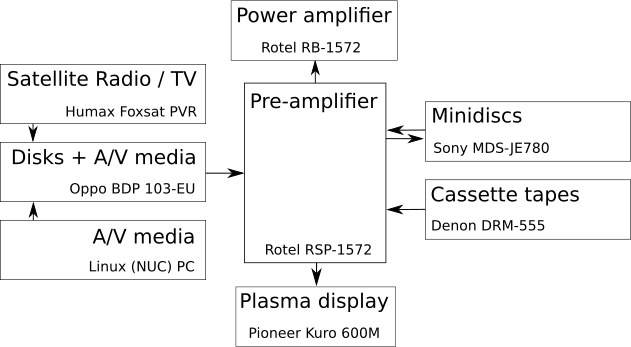Video system
[last updated: 29 October 2016]

The audio side of the system is described here.
My multi-channel Rotel RSP-1572 A/V control pre-amp has seven digital audio and six HDMI inputs. Plus a 5.1 set of analogue inputs, and quite a few more stereo analogue pairs for good measure.1 It handles all incoming high-resolution digital audio formats.2
Digital video signal sources
DVDs and Blu-rays: The Oppo BD player contains a Qdeo video processing chipset to squeeze maximum video quality from standard definition3 480i/576i DVDs (and network video files) by upscaling everything to the native 1080p resolution of my plasma display. The Oppo is multi-region for all my DVD viewing, multi-zone for all my Blu-ray viewing, and handles any DVD-audio, CD or SACD listening.
A/V files: The Oppo is a competent network media streamer, adept at pulling video (and audio) files off my NAS boxes and presenting video to the Kuro at 1080p. (There are some streaming thoughts here.)
Satellite TV: When digital TV became the only game in town I fitted the 80cm dish we'd been using for Christa's analogue German TV with a new quad LNB and re-aligned it to the digital Astra II cluster to deliver a more robust "Freesat" signal. I watch almost no broadcast4 TV — my Humax Freesat PVR spends 99% of its time set to BBC radio.
TV sound: Transmitted TV sound in analogue days, although mono, was on a par with FM radio, so I used a separate TV sound tuner for a while. I avoided all forms of video recording until the arrival of so-called "VHS Hi-Fi". In 1983 I hired a Ferguson VHS Hi-Fi VCR (a JVC clone) to try for a year before buying two VCRs of my own. From then on, I always routed TV audio direct to the amplifier.
Drawbacks of digital?
HDCP is the bane of my (video) life, adding nothing but inconvenience, and ultimately forcing me to upgrade from a perfectly acceptable 50" 768p plasma to the 60" 1080p because of my need for HDCP handling via HDMI.
Don't get me started on the idiocy of variable Blu-ray user menu interfaces... Or BD Java... Or live interaction with other viewers over the Interweb thingy...